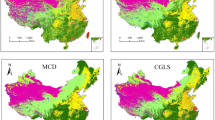Abstract
It is very difficult to have remote sensing data with both high spatial resolution and high temporal frequency; thus, two categories of land-use mapping methodology have been developed separately for coarser resolution and finer resolution data. The first category uses time series of data to retrieve the variation of land surface for classification, which are usually used for coarser resolution data with high temporal frequency. The second category uses fine spatial resolution data to classify different land surface. With the launch of Chinese satellite constellation HJ-1in 2008, four 30 m spatial resolution CCDs with about 360 km coverage for each one onboard two satellites made a revisit period of two days, which brought a new type of data with both high spatial resolution and high temporal frequency. Therefore, by taking the spatiotemporal advantage of HJ-1/CCD data we propose a new method for finer resolution land cover mapping using the time series HJ-1/CCD data, which can greatly improve the land cover mapping accuracy. In our two study areas, the very high resolution remote sensing data within Google Earth are used to validate the land cover mapping results, which shows a very high mapping accuracy of 95.76% and 83.78% and a high Kappa coefficient of 0.9423 and 0.8165 in the Dahuofang area of Liaoning Province and the Heiquan area of Gansu Province respectively.
Similar content being viewed by others
References
Chavez P S. 1996. Image-based atmospheric corrections—revisited and revised. Photogramm Eng Remote Sens, 62: 1025–1036
Foley J A, DeFries R, Asner C, et al. 2005. Global consequences of land use. Science, 309: 570–574
Friedl M A, Mciver D K, Hodges J C F, et al. 2002. Global land cover mapping from MODIS: Algorithms and early results. Remote Sens Environ, 83: 287–302
Friedl M A, Sulla-Menashe D, Tan B, et al. 2010. MODIS collection 5 global land cover: Algorithm refinements and characterization of new datasets. Remote Sens Environ, 114: 168–182
Gao B C, Kaufman Y J. 1998. The MODIS Near-IR water vapor algorithm. Products: MOD05, MOD08. ATBD Reference Number: ATBD-MOD-03
Gong P, Wang J, Yu L, et al. 2013. Finer resolution observation and monitoring of global land cover: First mapping results with Landsat TM and ETM+ data. Int J Remote Sens, 34:2607–2654
Hall F G, Bergen K, Blair J B, et al. 2011. Characterizing 3D vegetation structure from space: Mission requirements. Remote Sens Environ, 115: 2753–2775
Hansen M C, DeFries R S, Townshend J R G, et al. 2000. Global land cover classification at 1 km spatial resolution using a classification tree approach. Int J Remote Sens, 21: 1331–1364
HASI B, Ma J W, Li Q Q, et al. 2003. Research on classification and organization feature map neural network from ASTER data based on wavelet fusion. Sci China Ser D-Earth Sci, 33: 895–902
HASI B, Ma J W, Li Q Q, et al. 2004. Tolerance rough set and neural network classification of remote sensing. Sci China Ser D-Earth Sci, 34: 967–974
Jung M, Henkel K, Herold M, et al. 2006. Exploiting synergies of global land cover products for carbon cycle modeling. Remote Sens Environ, 101: 534–553
Li S, Li W Z, Zhou J J, et al. 2008. Urban land cover composition abundance extraction of sub-pixel level based on ETM+ image: A Case study of Nanjing. Geogr Geo-Info Sci, 24: 17–22
Liang L, Xu B, Chen Y, et al. 2010. Combining spatial-temporal and phylogenetic analysis approaches for improved understanding on global H5N1 transmission. PLoS One, 5: e13575
Liu X P, Li X, Peng X J, et al. 2007. Swarm intelligence for classification of remote sensing data. Sci China Ser D-Earth Sci, 37: 1400–1408
Loveland T R, Reed B C, Brown J F, et al. 2000. Development of a global land cover characteristics database and IGBP DISCover from 1 km AVHRR data. Int J Remote Sens, 21: 1303–1330
Pal M, Mather P M. 2005. Support vector machines for classification in remote sensing. Int J Remote Sens, 26: 1007–1011
Poulter B, Frank D C, Hodson E L, et al. 2011. Impacts of land cover and climate data selection on understanding terrestrial carbon dynamics and the CO2 airborne fraction. Biogeosciences, 8: 2027–2036
Running S W. 2008. Ecosystem disturbance, carbon, and climate. Science, 321: 652–653
Shen S H, Yang S B, Li B B, et al. 2009. A scheme for regional rice yield estimation using ENVISAT ASAR data. Sci China Ser D-Earth Sci, 6: 763–773
Yan J Z, Zhang Y L, Bai W Q, et al. 2005. Land cover changes based on plant successions deforestation, rehabilitation and degeneration of forest in the upper Dadu River watershed. Sci China Ser D-Earth Sci, 35: 1160–1073
Zhang H X, Bian Z F, Chen Q C. 2008. Study on the accuracy of land cover classification of ETM+ remote sensing image fusion method. J Anhui Agri Sci, 36: 62–65
Zhang Z X, Wang X, Wang C Y, et al. 2009. National land cover mapping by remote sensing under the control of interpreted data. J Geo-Info Sci, 11: 216–214
Zhao Y M, Tian G H, He R Z, et al. 2006. Fractal of land cover in Kaifeng city based on RS and GIS. Chin J Ecol, 25: 1218–1222
Zheng S, Cao C X, Cheng J Q, et al. 2011. A study on land use and land cover change during urbanization in Shenzhen using data from Chinese satellites. Sci China Info Sci, 41(Suppl): 140–152
Author information
Authors and Affiliations
Corresponding author
Rights and permissions
About this article
Cite this article
Zhong, B., Ma, P., Nie, A. et al. Land cover mapping using time series HJ-1/CCD data. Sci. China Earth Sci. 57, 1790–1799 (2014). https://doi.org/10.1007/s11430-014-4877-5
Received:
Accepted:
Published:
Issue Date:
DOI: https://doi.org/10.1007/s11430-014-4877-5




